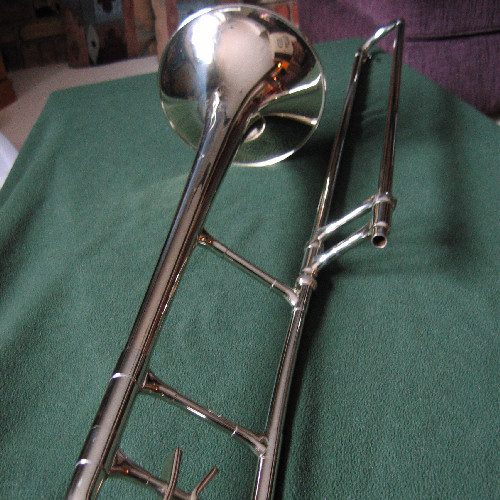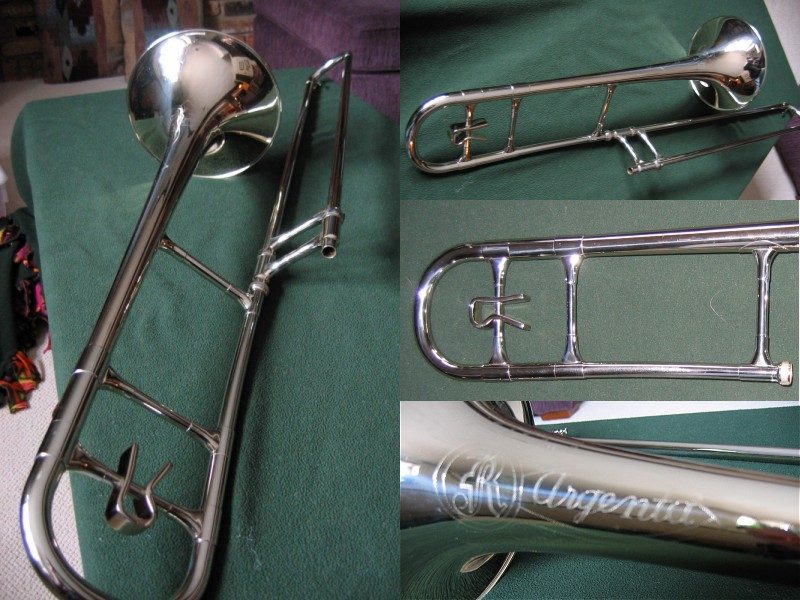
Introduced in 1959, the Reynolds Argenta trombone is a medium-bore (.520″) tenor trombone made of solid nickel-silver.
The Argenta line of instruments (trumpet, cornet, trombone) were developed around the time that Reynolds created nickel-silver versions of their Pottag and Chambers model French horns. With the same specifications as the medium-bore Contempora tenor trombone, the nickel-silver Argenta and bronze-alloy bell Contempora models offer proficient trombonists a choice of tonal alternatives to traditional yellow brass.
1959-1961
Roth-Reynolds (Cleveland, Ohio)
Solid nickel silver. This exciting new creation has already won wide-spread acclaim amongst professional musicians who admire its fuller more robust tone and excellent high register. The most remarkable trombone in any band because of its brilliant quality and very striking appearance. Built in large bore .520" with 8½ inch bell, slide and bell lock. One piece light weight slide hard chrome plated. Tone starts without effort and is easily developed to astonishing proportions.
1961-1964
RMC/Reynolds (Cleveland, Ohio)
Sometime after Richards Music purchased Reynolds in 1961, the product catalog was renumbered. The old numbers were replaced with a new scheme that reflected the type of instrument. To the best of knowledge, the instrument specifications did not change, just the model numbers.
Model TO-26
Argenta Tenor Trombone
Bore: .520"
Bell: 8½"
Materials: solid nickel silver
Slide: chrome-plated inner slides, nickel-silver outer slides
Finish: clear lacquer finish; optional silverplate bright bell or silverplate gold bell finish
Designed for musicians who prefer a rich "dark" type of tone and unique response that this solid nickel-silver tenor trombone produces. Large bore and 8½ inch bell enables the musicians to obtain the "big sound" with the extra measure of mellowness that nickel silver adds. Same high-quality construction features of other top grade models.
1964-1973
Reynolds (Fullerton, Calif.; Abilene, Texas)
After CMI purchased the assets to Reynolds, trumpets, cornets, trombones and French horns were made at the Olds factory in Fullerton, Calif. There were slight adjustments to the model specifications compared to the Cleveland instruments. Models made after 1964 have a smaller bore size and are lighter weight in construction and sound than the original Cleveland horns. Bell and slide sections from the different manufacturing plants do not fit perfectly together and the slide lengths and widths are slightly different as well. The Argenta model was discontinued c.1973 and its place in the Reynolds catalog was taken by the nickel-plated Onyx trombone.
Pure nickel-silver with large bore and 8½” bell to produce that “big dark sound.”
Solid nickel-silver construction darkens and softens the tone to produce the timbre sought by many of today's top players. Very responsive throughout all registers. Straight .515" bore; 8½" bell.
NOTES
According to Reynolds’ trademark application, the Spanish word "Argenta" means "silver." It is a form of the verb argentar and more accurate translations might be "to silver plate" or "to give a silvery shine to." The Argenta line of horns were some of very few band instruments, other than French horns, made completely of solid nickel silver.
Despite its close appearance, there is no actual silver in nickel silver. Nickel silver, also known as German silver or neusilber, is an alloy of copper, zinc and nickel. A representative alloy mix contains 65% copper, 17% zinc and 18% nickel (compared to 80% copper and 20% zinc for standard yellow brass). Nickel silver has similar characteristics to brass, but is harder and stiffer, making it a durable alternative often used on high-wear areas of a horn, including valve casings, hand grips, tuning slides and trim.
The purpose of this website is to preserve the history of the F. A. Reynolds Company and the distinctive qualities of its brass instruments. Contempora Corner and contemporacorner.com are not related or associated in any way to the former or current F.A. Reynolds Company.
Copyright © 2004-2024 ElShaddai Edwards. All Rights Reserved. Terms of Use.



![Model TO-26 [SN 61290]. Photos used with permission from Norman Rowe.](https://contemporacorner.com/wp-content/uploads/2009/01/061290.jpg)

![Model TO-26 [SN 238062]. Photos used with permission from ElShaddai Edwards.](https://contemporacorner.com/wp-content/uploads/2009/01/238062.jpg)